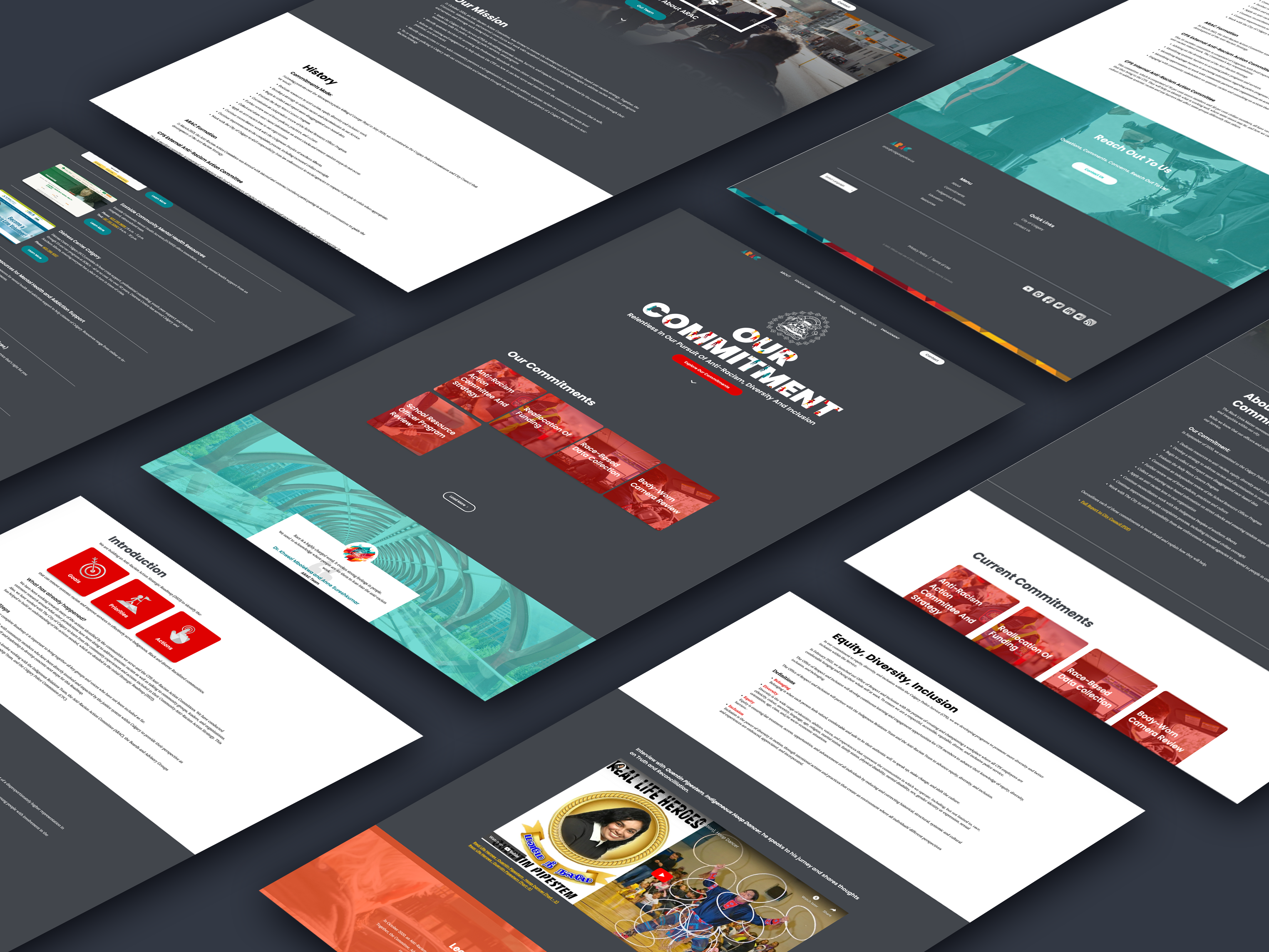The Project
The goal of this project is to promote a sense of belonging, inclusivity, and diversity on Mount Royal University's campus. Students from various backgrounds face many different challenges in finding their place on campus, including a lack of representation in student groups, curriculum, and extracurricular activities. The absence of a supportive and inclusive campus culture creates a feeling of isolation and disconnection, which hinders students' personal and academic growth. Therefore, there is a need for a comprehensive approach that focuses on creating a campus culture that embraces diversity, equity, and inclusion by fostering safe and supportive spaces for all students to thrive.
Design Process
Design Thinking Approach
My team and I designed a general education elective to adhere to Mount Royal University's guidelines to address dwindling campus culture. During the design process, I used the design thinking framework to place the target audience as the central figure to design for. The process was as followed:
1. Empathize & Define: User and data analysis and proposal.
2. Ideate: Direction Statement, solutions and present
3. Prototype & Test: Develop a prototype, critique & feedback, and repeat.
Define
User Research & Data Collection
The effectiveness of this project relies on the understanding of the user's needs and wants. My team and I conducted research to understand potential pain points through a combination of ethnographic and secondary research. The ethnographic research consisted of observational frameworks, highlighting how students interacted with resources already available to them in the context of getting involved with campus activities, and we conducted basic interviews and surveys to gauge the current interest and mindset students have about various campus activities. Our desk research collected data on current MRU initiatives on campus engagement, this included elements such as events, clubs, sports, recreation, career services, fairs, etc. and another aspect of desk research involved a social media analysis to understand what students were sharing online about the current atmosphere on campus.
Propose
Understanding that campus culture has the potential to positively affect students' well-being, my team and I brainstormed various aspects of what constitutes campus culture and organized them into subcategories for further grouping and division. We developed a short presentation to present our ideas to other MRU innovators to gain initial feedback and thoughts. Our presentation consisted of mind maps which allowed us to quickly brainstorm ideas on issues/problems on campus, we then organized our findings in a "circle of impact" to draw on various connections and overlap. This initial organization allowed us to derive subcategories ultimately allowing us to infer that campus culture is largely contributing to negative experiences. We then went on to do a second round of brainstorming based solely on campus culture to gain a deeper understanding of the topic, another "circle of impact" was made to understand the areas that could be controlled, what can be influenced, and areas that are of concern.
Ideate
Direction Statement
From our empathizing and defining stage, we created a direct statement that provided a concrete framework for our ideation process. We referred back to our direction statement throughout the process of creating our prototype.
Direction Statement: Guide MRU students towards continuous involvement in MRU campus life, and promote a sense of community.
Direction Statement Definitions:
1. Guide: To give a clearer understanding of how to get involved.
2. MRU Students: All new and current students.
3. Continuous Involvement: Nurturing active MRU community members.
4. MRU Campus Life: Including events, clubs, sports, education, classes, and spaces.
5. Promote: To encourage and foster opportunities.
6. Sense of Community: Friendships, groups, or feelings of belonging within MRU.
Solution
Our solution to promote a sense of belonging and community at MRU was to create a new foundation general education elective that is structured around joining and actively partaking in campus clubs. This elective serves the purpose of a general education class (GNED) because it provides students with the opportunity to expand their knowledge outside their core program requirements. A class where students get credit for participating in campus activities provides clubs with more support and provides students with the ability to find a new interest, connect with peers, and build a stronger campus culture. Students can connect while attaining GNED goals such as experiencing multidisciplinary perspectives, discovering new passions, and learning new interpersonal or hard skills.
1. Continuous Involvement on Campus: Create an environment where students are actively participating in campus activities and are excited about fostering new relationships throughout their careers at MRU.
2. Promote a Sense of Community: Form a close-knit group of students who are passionate about promoting a positive campus culture atmosphere for new and current students.
Present
We presented our idea by outlining the definitions of what makes a General Education course and orientated it in a way that would excite students to participate in it. We presented a course syllabus for the course and outlined the motivations behind, expectations and assignments. We presented our idea by stating the problem – Students lacking school spirit, especially since the COVID-19 complications and structured the presentations on the positive aspects MRU has and how we can exploit those elements to strengthen community identity and school spirit. A possible action point we determined that was being underutilized was the diverse networks of clubs Mount Royal has that are community-based and developed by students. They are filled with some of the school's most determined and enthusiastic people and are ideal for leading an initiative to shift campus culture. Our presentation informed other MRU innovators about how students sometimes are bogged down or feel intimidated when wanting to join a club and so our idea would allow students to express new interests, learn new skills, and build a network of people; the very essence of what a general education class is supposed to be.
Prototype & Test
Develop Prototype
Prototyping a possible new course could take on any form, however, we decided to choose a draft sample of a course syllabus. The syllabus included all required course information such as faculty members, course description, the learning outcomes, course material, assignments & mark allocations, schedule plan, MRU club catalogue, and grading structure. The prototype presented was/is designed with the understanding that a new course will be subject to change as it undergoes its initial implementation. Revisions will be used to ensure that the course achieves its goals and that the students are receiving the benefits of a General Education class. Although revisions are essential for the longevity of the class, the original development of the course needs to experience critical observation and critiques to ensure that the first deployment acts in the best interest of the class.
Critique & Feedback
The initial presentation of our idea received a critical analysis from peers to critique certain structures and the effectiveness of our idea. Being in a small group, we are subject to biased opinions due to a lack of diversity in experiences and thinking. By having our ideas checked by a larger group of 20, we can find the differences between our ways of thinking. During this critique, we were made aware of these shortcomings:
1. What happens if the club fails?
2. What guidelines are in place for approving a club?
3. What are the rules pertaining to drug and alcohol usage?
4. What is defined as campus culture?
And Repeat
One round of critical critiques will inevitably cause the course (or any product for that matter) to fail. Consistent revisions, iterations, and conversations with various stakeholders, designers, and users are needed to ensure that the idea is effective and that it adapts to changing conditions over time. As MRU continues to grow and curriculum design adopts new technologies, courses and their structures need to change with it to allow students to maximize their education and to ensure that the material stays relevant. This project never received another large critical analysis, but, it is crucial to note that more in-depth critiques and tests would need to be done on higher-up stakeholders and potential users and would need to apply in a real-use scenario to understand the course's full effects.
Reflection
What's Next & Limitations
1. More in-depth testing of the product needs to be done. Ideally, after more analysis from stakeholders, deans, professors, and students, a trial run would take place that would be heavily monitored and tested by real students. Testing like this can be expensive and time-consuming with a high failure rate, but, innovative work to improve education for students is necessary.
2. Curriculum design needs to be vetted. The assignments and course schedule were created and drafted by experienced undergraduate students and not by industry experts. To ensure that the assignments meet the goals of the course, a professional needs to ensure that the assignments are appropriate to the learning objectives.
3. Data collection and research on the current state of campus culture need to be analyzed because we have only created a course that applies to the willing few students who would choose to take the class. How can we create ways that engage other students to participate in campus activities?
Lessons Learned
I learned that the design process can and should be utilized in many diverse fields as it creates a structured approach to understanding the needs of the users to solve problems in an innovative way. When I first began this project I had a preconceived notion of basic school spirit bluffs and never thought to create something this extensive to address campus culture. During the define and empathize phase, I learned that students have a hard time committing to campus activities for reasons such as not having enough time, they don't know what is out there to join and that they are scared to join something unknown and new. This initial research paved the way to integrate ideas that would allow students to explore new opportunities, in an inviting way. Through this, I learned that how I viewed campus culture and the barriers that exist are vastly different from other people's perspectives. For UX and human-centred products, assumptions should not be made and when there is a time crunch or a lack of resources, it is easy to create falsities based on presumptions.





